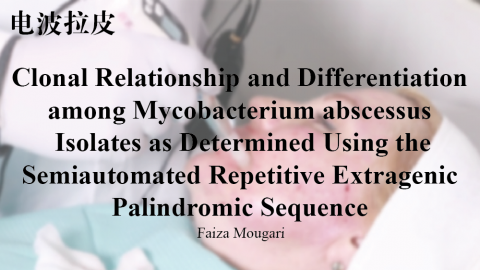
- 4003人
- 分享收藏
Clonal Relationship and Differentiation among Mycobacterium abscessus Isolates as Determined Using
Faiza Mougari
简介
【 文献重点摘要 】
Mycobacterium abscessus is a rapidly growing mycobacterium that causes respiratory tract infections in predisposed patients, such as those with cystic fibrosis and nosocomial skin and soft tissue infections. In order to investigate the clonal relationships between the strains causing epidemic episodes, we evaluated the discriminatory power of the semiautomated DiversiLab (DL) repetitive extragenic palindromic sequence PCR (REP-PCR) test for M. abscessus genotyping. Since M. abscessus was shown to be composed of subspecies (M. abscessus subsp. massiliense, M. abscessus subsp. bolletii, and M. abscessus subsp. abscessus), we also evaluated the ability of this technique to differentiate subspecies. The technique was applied to two collections of clinical isolates, (i) 83 M. abscessus original isolates (43 M. abscessus subsp. abscessus, 1 2 M. abscessus subsp. bolletii, and 28 M. abscessus subsp.massiliense) from infected patients and (ii) 35 repeated isolates obtained over 1 year from four cystic fibrosis patients. The DL REP-PCR test was standardized for DNA extraction, DNA amplification, and electrophoresis pattern comparisons. Among the isolates from distinct patients, 53/83 (62%) isolates showed a specific pattern, and 30 were distributed in 11 clusters and 6 patterns, with 2 to 4 isolates per pattern. The clusters and patterns did not fully correlate with multilocus sequence typing (MLST) analysis results. This revealed a high genomic diversity between patients, with a discriminatory power of 98% (Simpson’s diversity index). However, since some isolates shared identical patterns, this raises the question of whether it is due to transmission between patients or a common reservoir. Multiple isolates from the same patient showed identical patterns, except for one patient infected by two strains. Between the M. abscessus subspecies, the indexes were <70%, indicating that the DL REP-PCR test is not an accurate tool for identifying organisms to the subspecies level. REP-PCR appears to be a rapid genotyping method that is useful for investigating epidemics of M. abscessus infections.
脓肿分枝杆菌是一种快速生长的分枝杆菌,可导致易感患者的呼吸道感染,如囊性纤维化和医院皮肤和软组织感染患者。为了研究引起流行的菌株之间的克隆关系,我们评价了半自动化的多样性重复基因外回文序列聚合酶链反应(REP-PCR)试验对脓肿分枝杆菌基因分型的鉴别能力。因为表明脓肿分枝杆菌由亚种组成(脓肿分枝杆菌亚种。massiliense,m .脓肿亚种。棉桃小食心虫和脓肿分枝杆菌亚种。我们还评估了这种技术区分亚种的能力。该技术应用于两个临床分离株的收集:(1)83个脓肿分枝杆菌原始分离株(43个脓肿分枝杆菌亚种)。脓肿,1 2 M脓肿亚种。bolletii和28个脓肿分枝杆菌massielense亚种)和(ii) 35个重复分离物,这些分离物在1年内从4个囊性纤维化患者中获得。脱氧核糖核酸重复聚合酶链反应试验是标准化的,用于脱氧核糖核酸提取、脱氧核糖核酸扩增和电泳模式比较。在来自不同患者的分离株中,53/83 (62%)分离株显示出特定的模式,30个分离株分布在11个群和6个模式中,每个模式有2至4个分离株。聚类和模式与多位点序列分型(MLST)分析结果不完全相关。这揭示了患者之间的高基因组多样性,具有98%的辨别能力(辛普森多样性指数)。然而,由于一些分离株具有相同的模式,这就提出了一个问题,即这是由于患者之间的传播还是由于共同的宿主。来自同一患者的多个分离株显示出相同的模式,除了一名患者被两种菌株感染。在脓肿分枝杆菌亚种之间,指数< 70%,表明DL REP-PCR试验不是在亚种水平上鉴定生物的准确工具。重复聚合酶链反应似乎是一种快速基因分型方法,可用于调查脓肿分枝杆菌感染的流行。



